Business Law Assignment - Contract, Negligence, and Liability
VerifiedAdded on 2022/08/09
|10
|2455
|483
Homework Assignment
AI Summary
This business law assignment provides a comprehensive analysis of contract law and negligence, focusing on Australian legal principles. The assignment is divided into three parts, each addressing a distinct legal issue. Part A examines the enforceability of a contract with a minor, evaluating whether Ted can sue Ann for breach of contract. Part B delves into negligence, exploring whether Brown can claim damages from a manufacturer for a defective product. This section references the duty of care and product liability. Part C analyzes a case of accidental injury involving negligence, assessing Jonas's accountability for his father's injuries. The analysis incorporates relevant case law, including Nash v. Inman, Donoghue v. Stevenson, and Grant v. Australian Knitting Mills, to provide a thorough understanding of the legal principles involved and their practical application to each scenario. The assignment concludes with clear legal conclusions for each scenario.
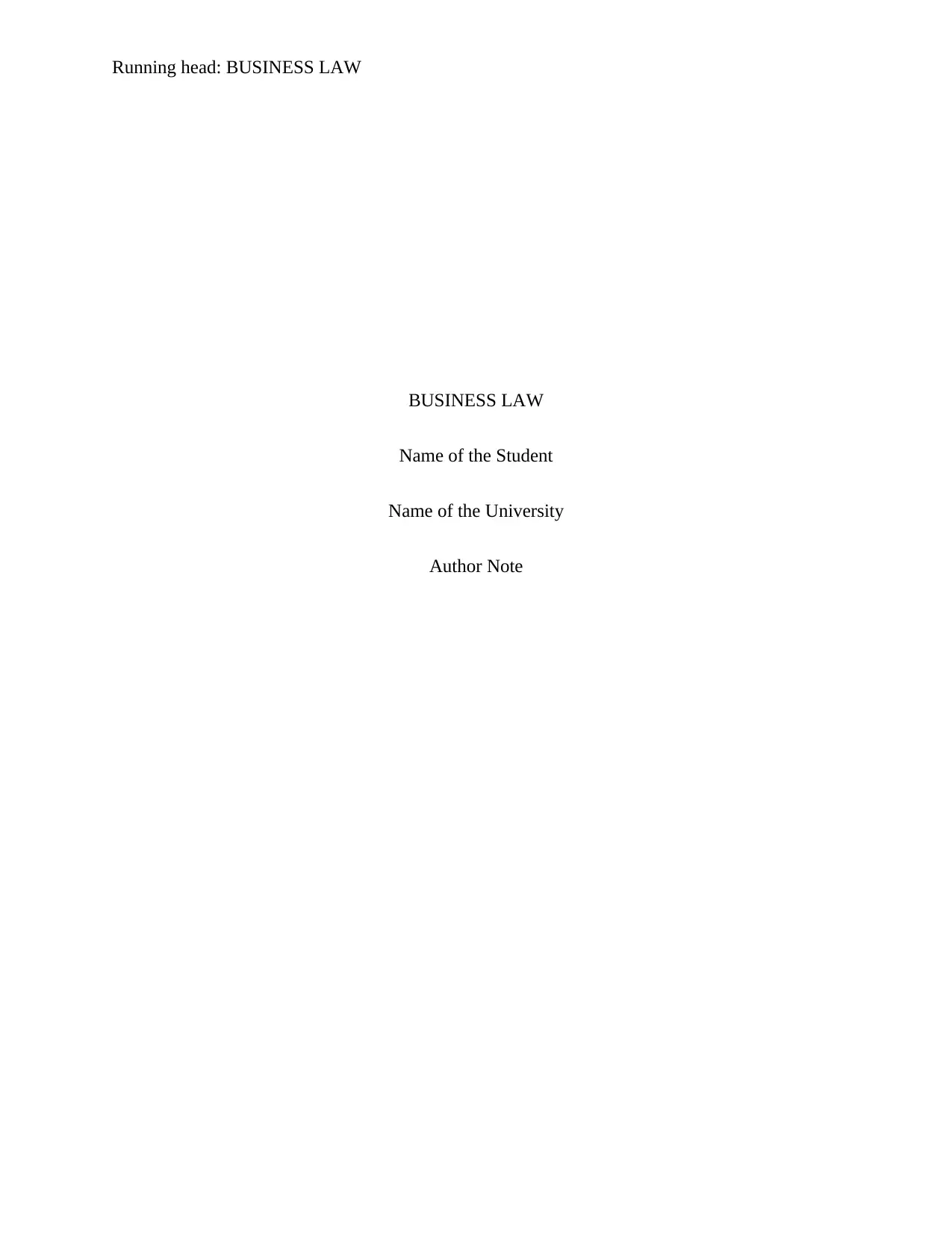
Running head: BUSINESS LAW
BUSINESS LAW
Name of the Student
Name of the University
Author Note
BUSINESS LAW
Name of the Student
Name of the University
Author Note
Paraphrase This Document
Need a fresh take? Get an instant paraphrase of this document with our AI Paraphraser
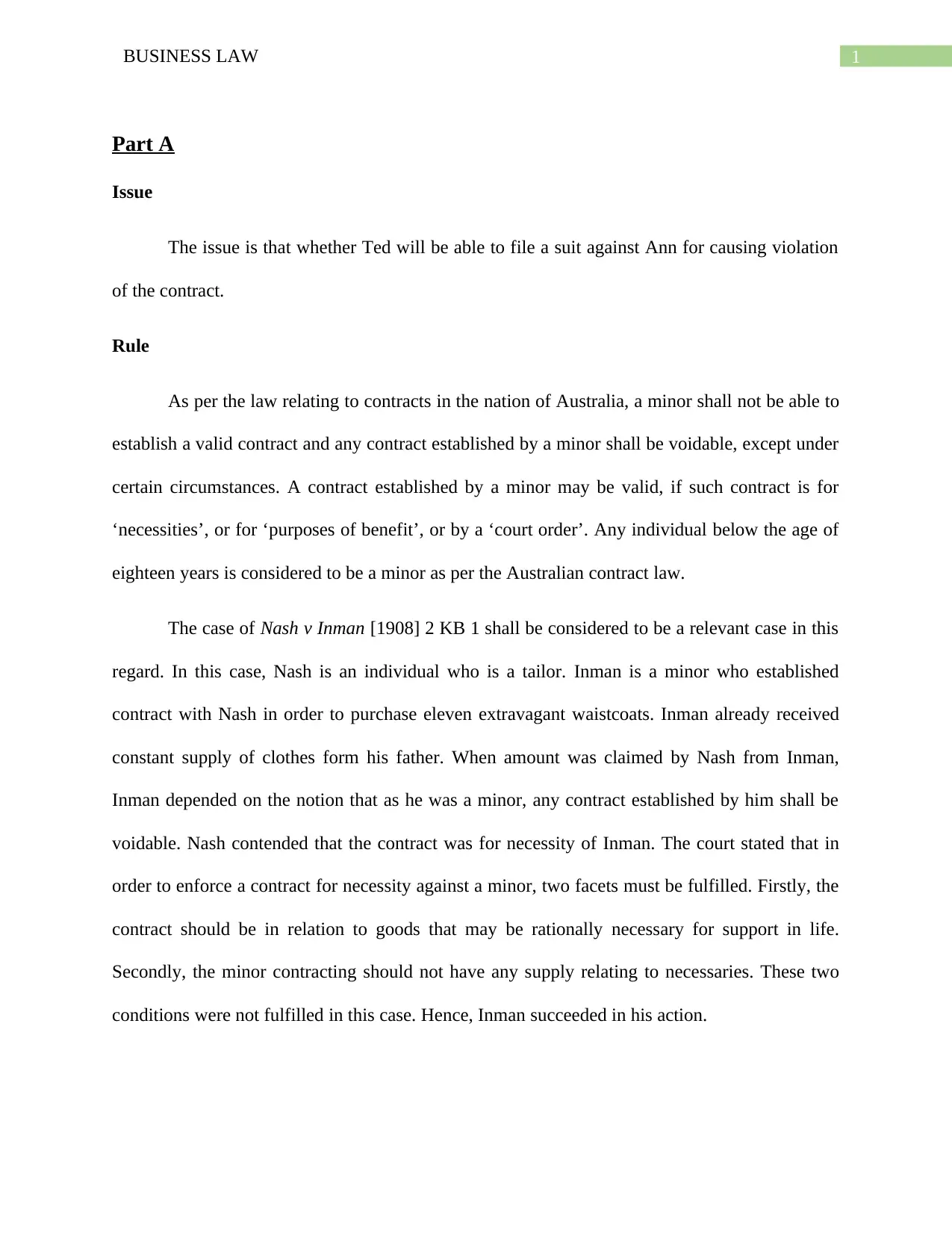
1BUSINESS LAW
Part A
Issue
The issue is that whether Ted will be able to file a suit against Ann for causing violation
of the contract.
Rule
As per the law relating to contracts in the nation of Australia, a minor shall not be able to
establish a valid contract and any contract established by a minor shall be voidable, except under
certain circumstances. A contract established by a minor may be valid, if such contract is for
‘necessities’, or for ‘purposes of benefit’, or by a ‘court order’. Any individual below the age of
eighteen years is considered to be a minor as per the Australian contract law.
The case of Nash v Inman [1908] 2 KB 1 shall be considered to be a relevant case in this
regard. In this case, Nash is an individual who is a tailor. Inman is a minor who established
contract with Nash in order to purchase eleven extravagant waistcoats. Inman already received
constant supply of clothes form his father. When amount was claimed by Nash from Inman,
Inman depended on the notion that as he was a minor, any contract established by him shall be
voidable. Nash contended that the contract was for necessity of Inman. The court stated that in
order to enforce a contract for necessity against a minor, two facets must be fulfilled. Firstly, the
contract should be in relation to goods that may be rationally necessary for support in life.
Secondly, the minor contracting should not have any supply relating to necessaries. These two
conditions were not fulfilled in this case. Hence, Inman succeeded in his action.
Part A
Issue
The issue is that whether Ted will be able to file a suit against Ann for causing violation
of the contract.
Rule
As per the law relating to contracts in the nation of Australia, a minor shall not be able to
establish a valid contract and any contract established by a minor shall be voidable, except under
certain circumstances. A contract established by a minor may be valid, if such contract is for
‘necessities’, or for ‘purposes of benefit’, or by a ‘court order’. Any individual below the age of
eighteen years is considered to be a minor as per the Australian contract law.
The case of Nash v Inman [1908] 2 KB 1 shall be considered to be a relevant case in this
regard. In this case, Nash is an individual who is a tailor. Inman is a minor who established
contract with Nash in order to purchase eleven extravagant waistcoats. Inman already received
constant supply of clothes form his father. When amount was claimed by Nash from Inman,
Inman depended on the notion that as he was a minor, any contract established by him shall be
voidable. Nash contended that the contract was for necessity of Inman. The court stated that in
order to enforce a contract for necessity against a minor, two facets must be fulfilled. Firstly, the
contract should be in relation to goods that may be rationally necessary for support in life.
Secondly, the minor contracting should not have any supply relating to necessaries. These two
conditions were not fulfilled in this case. Hence, Inman succeeded in his action.
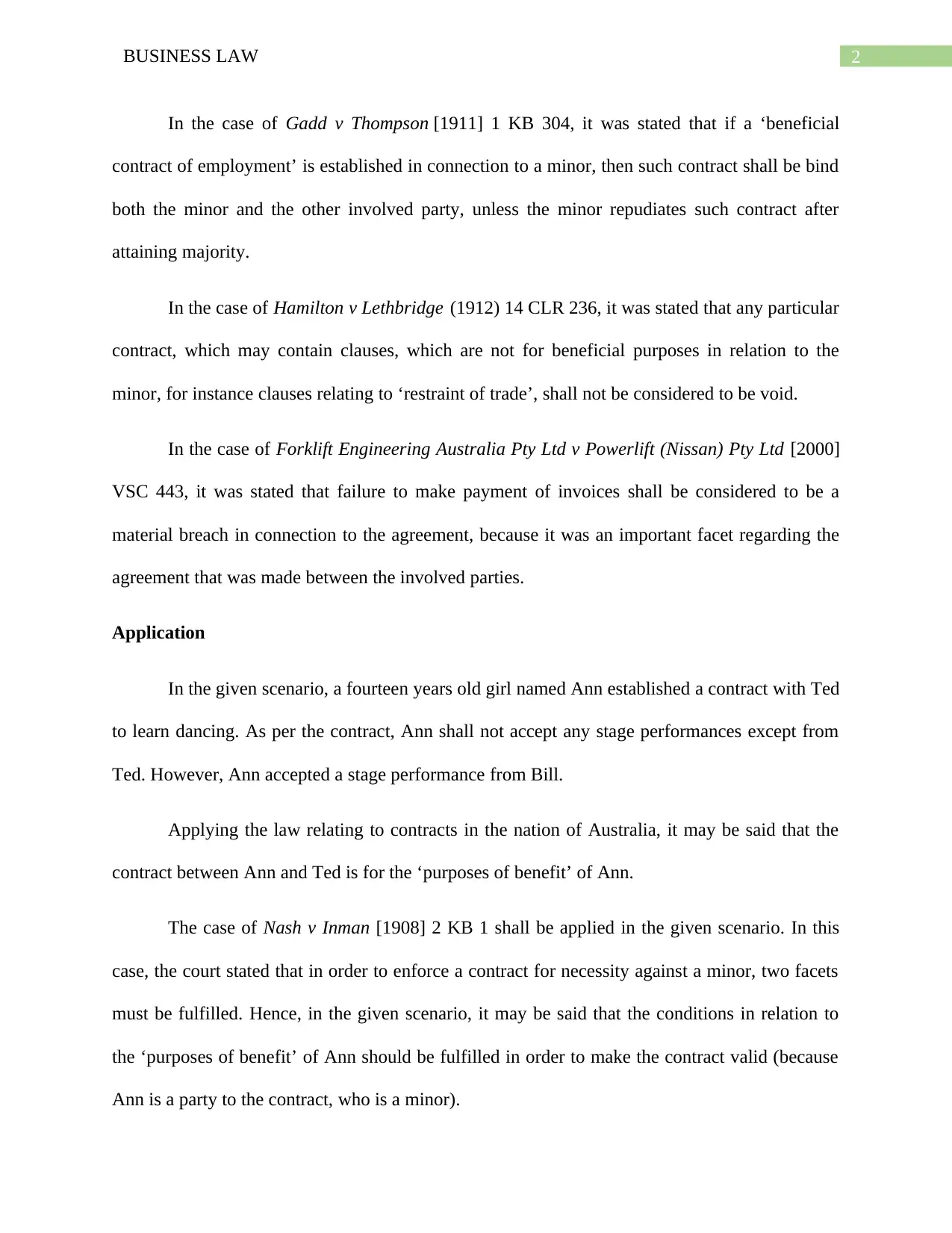
2BUSINESS LAW
In the case of Gadd v Thompson [1911] 1 KB 304, it was stated that if a ‘beneficial
contract of employment’ is established in connection to a minor, then such contract shall be bind
both the minor and the other involved party, unless the minor repudiates such contract after
attaining majority.
In the case of Hamilton v Lethbridge (1912) 14 CLR 236, it was stated that any particular
contract, which may contain clauses, which are not for beneficial purposes in relation to the
minor, for instance clauses relating to ‘restraint of trade’, shall not be considered to be void.
In the case of Forklift Engineering Australia Pty Ltd v Powerlift (Nissan) Pty Ltd [2000]
VSC 443, it was stated that failure to make payment of invoices shall be considered to be a
material breach in connection to the agreement, because it was an important facet regarding the
agreement that was made between the involved parties.
Application
In the given scenario, a fourteen years old girl named Ann established a contract with Ted
to learn dancing. As per the contract, Ann shall not accept any stage performances except from
Ted. However, Ann accepted a stage performance from Bill.
Applying the law relating to contracts in the nation of Australia, it may be said that the
contract between Ann and Ted is for the ‘purposes of benefit’ of Ann.
The case of Nash v Inman [1908] 2 KB 1 shall be applied in the given scenario. In this
case, the court stated that in order to enforce a contract for necessity against a minor, two facets
must be fulfilled. Hence, in the given scenario, it may be said that the conditions in relation to
the ‘purposes of benefit’ of Ann should be fulfilled in order to make the contract valid (because
Ann is a party to the contract, who is a minor).
In the case of Gadd v Thompson [1911] 1 KB 304, it was stated that if a ‘beneficial
contract of employment’ is established in connection to a minor, then such contract shall be bind
both the minor and the other involved party, unless the minor repudiates such contract after
attaining majority.
In the case of Hamilton v Lethbridge (1912) 14 CLR 236, it was stated that any particular
contract, which may contain clauses, which are not for beneficial purposes in relation to the
minor, for instance clauses relating to ‘restraint of trade’, shall not be considered to be void.
In the case of Forklift Engineering Australia Pty Ltd v Powerlift (Nissan) Pty Ltd [2000]
VSC 443, it was stated that failure to make payment of invoices shall be considered to be a
material breach in connection to the agreement, because it was an important facet regarding the
agreement that was made between the involved parties.
Application
In the given scenario, a fourteen years old girl named Ann established a contract with Ted
to learn dancing. As per the contract, Ann shall not accept any stage performances except from
Ted. However, Ann accepted a stage performance from Bill.
Applying the law relating to contracts in the nation of Australia, it may be said that the
contract between Ann and Ted is for the ‘purposes of benefit’ of Ann.
The case of Nash v Inman [1908] 2 KB 1 shall be applied in the given scenario. In this
case, the court stated that in order to enforce a contract for necessity against a minor, two facets
must be fulfilled. Hence, in the given scenario, it may be said that the conditions in relation to
the ‘purposes of benefit’ of Ann should be fulfilled in order to make the contract valid (because
Ann is a party to the contract, who is a minor).
⊘ This is a preview!⊘
Do you want full access?
Subscribe today to unlock all pages.

Trusted by 1+ million students worldwide
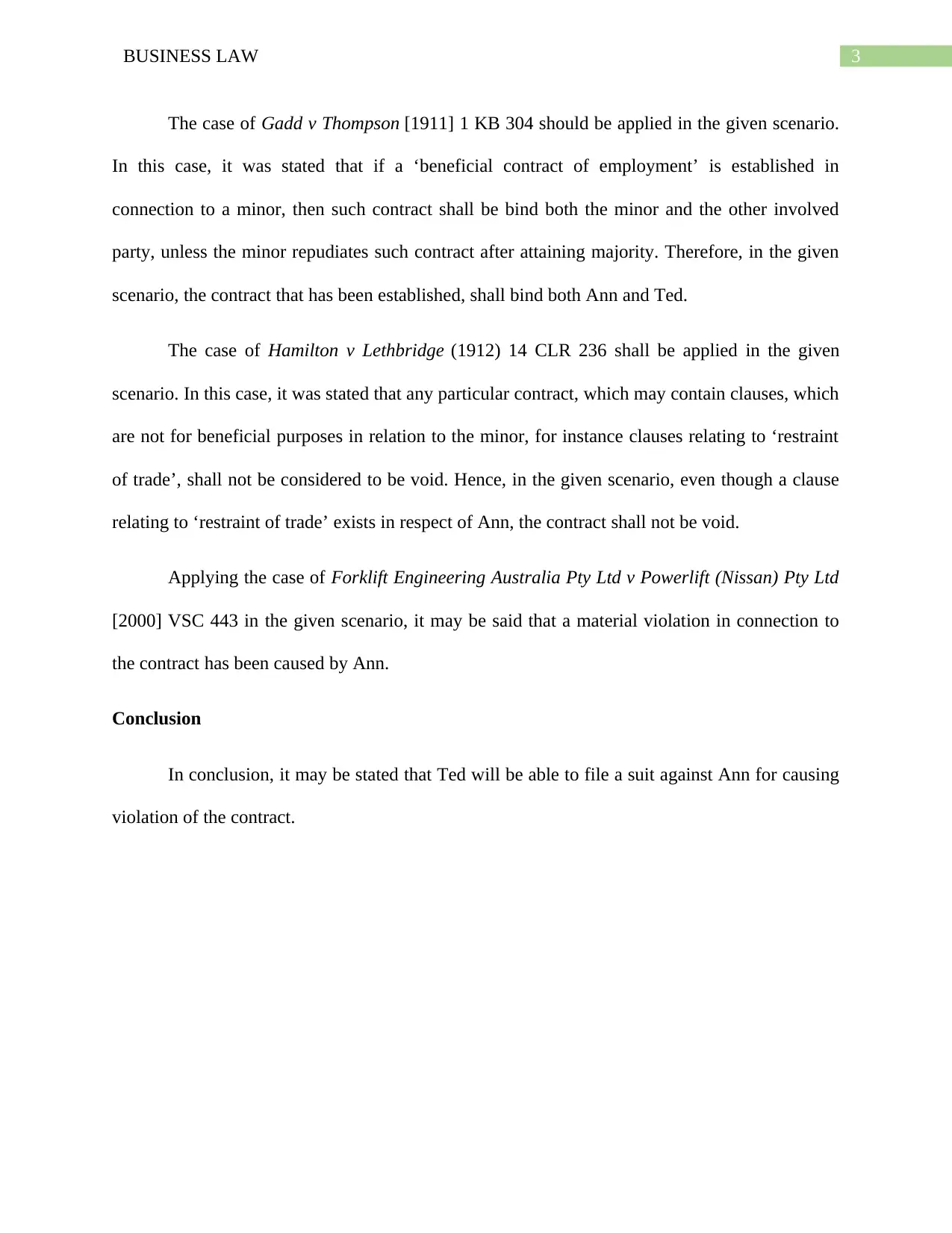
3BUSINESS LAW
The case of Gadd v Thompson [1911] 1 KB 304 should be applied in the given scenario.
In this case, it was stated that if a ‘beneficial contract of employment’ is established in
connection to a minor, then such contract shall be bind both the minor and the other involved
party, unless the minor repudiates such contract after attaining majority. Therefore, in the given
scenario, the contract that has been established, shall bind both Ann and Ted.
The case of Hamilton v Lethbridge (1912) 14 CLR 236 shall be applied in the given
scenario. In this case, it was stated that any particular contract, which may contain clauses, which
are not for beneficial purposes in relation to the minor, for instance clauses relating to ‘restraint
of trade’, shall not be considered to be void. Hence, in the given scenario, even though a clause
relating to ‘restraint of trade’ exists in respect of Ann, the contract shall not be void.
Applying the case of Forklift Engineering Australia Pty Ltd v Powerlift (Nissan) Pty Ltd
[2000] VSC 443 in the given scenario, it may be said that a material violation in connection to
the contract has been caused by Ann.
Conclusion
In conclusion, it may be stated that Ted will be able to file a suit against Ann for causing
violation of the contract.
The case of Gadd v Thompson [1911] 1 KB 304 should be applied in the given scenario.
In this case, it was stated that if a ‘beneficial contract of employment’ is established in
connection to a minor, then such contract shall be bind both the minor and the other involved
party, unless the minor repudiates such contract after attaining majority. Therefore, in the given
scenario, the contract that has been established, shall bind both Ann and Ted.
The case of Hamilton v Lethbridge (1912) 14 CLR 236 shall be applied in the given
scenario. In this case, it was stated that any particular contract, which may contain clauses, which
are not for beneficial purposes in relation to the minor, for instance clauses relating to ‘restraint
of trade’, shall not be considered to be void. Hence, in the given scenario, even though a clause
relating to ‘restraint of trade’ exists in respect of Ann, the contract shall not be void.
Applying the case of Forklift Engineering Australia Pty Ltd v Powerlift (Nissan) Pty Ltd
[2000] VSC 443 in the given scenario, it may be said that a material violation in connection to
the contract has been caused by Ann.
Conclusion
In conclusion, it may be stated that Ted will be able to file a suit against Ann for causing
violation of the contract.
Paraphrase This Document
Need a fresh take? Get an instant paraphrase of this document with our AI Paraphraser
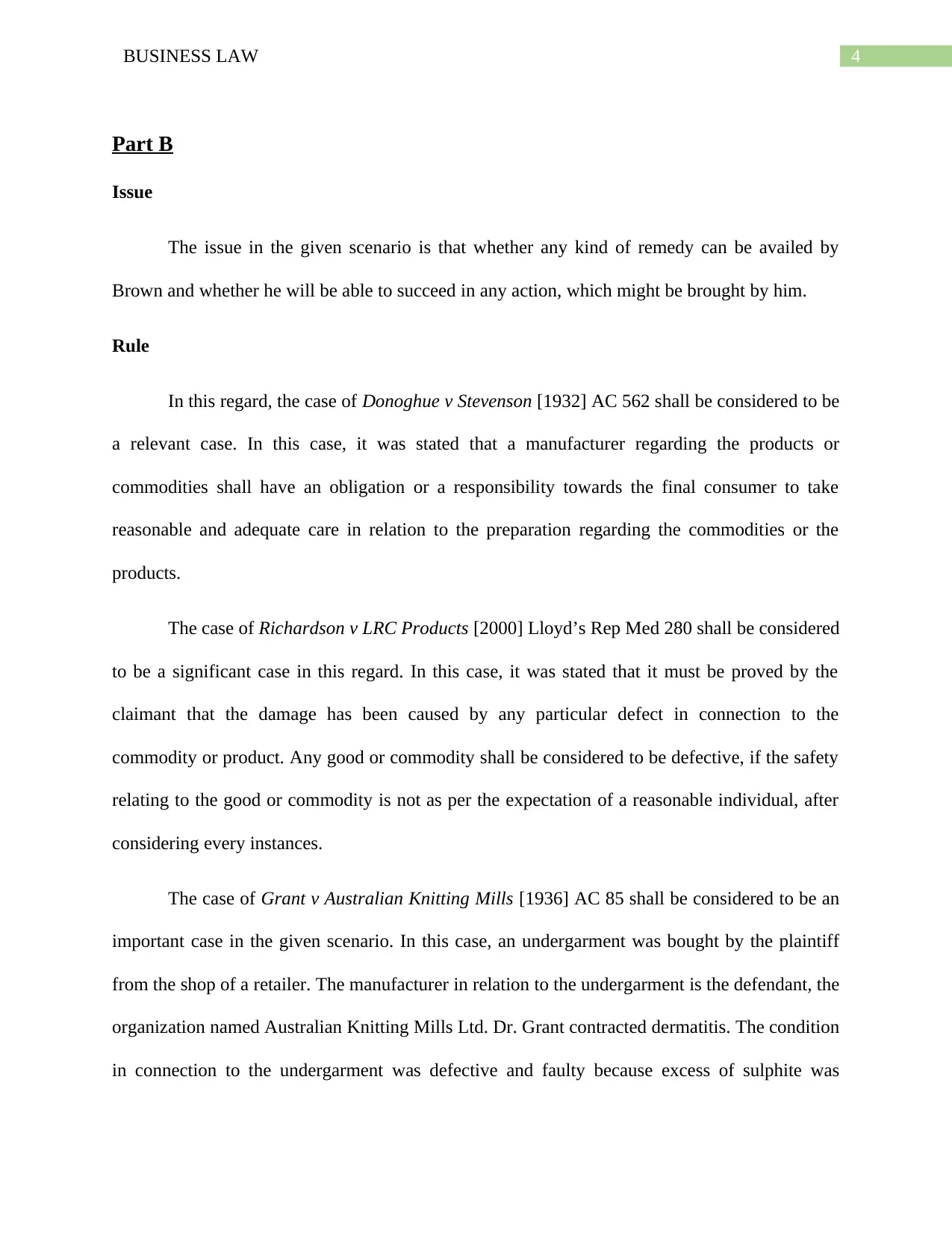
4BUSINESS LAW
Part B
Issue
The issue in the given scenario is that whether any kind of remedy can be availed by
Brown and whether he will be able to succeed in any action, which might be brought by him.
Rule
In this regard, the case of Donoghue v Stevenson [1932] AC 562 shall be considered to be
a relevant case. In this case, it was stated that a manufacturer regarding the products or
commodities shall have an obligation or a responsibility towards the final consumer to take
reasonable and adequate care in relation to the preparation regarding the commodities or the
products.
The case of Richardson v LRC Products [2000] Lloyd’s Rep Med 280 shall be considered
to be a significant case in this regard. In this case, it was stated that it must be proved by the
claimant that the damage has been caused by any particular defect in connection to the
commodity or product. Any good or commodity shall be considered to be defective, if the safety
relating to the good or commodity is not as per the expectation of a reasonable individual, after
considering every instances.
The case of Grant v Australian Knitting Mills [1936] AC 85 shall be considered to be an
important case in the given scenario. In this case, an undergarment was bought by the plaintiff
from the shop of a retailer. The manufacturer in relation to the undergarment is the defendant, the
organization named Australian Knitting Mills Ltd. Dr. Grant contracted dermatitis. The condition
in connection to the undergarment was defective and faulty because excess of sulphite was
Part B
Issue
The issue in the given scenario is that whether any kind of remedy can be availed by
Brown and whether he will be able to succeed in any action, which might be brought by him.
Rule
In this regard, the case of Donoghue v Stevenson [1932] AC 562 shall be considered to be
a relevant case. In this case, it was stated that a manufacturer regarding the products or
commodities shall have an obligation or a responsibility towards the final consumer to take
reasonable and adequate care in relation to the preparation regarding the commodities or the
products.
The case of Richardson v LRC Products [2000] Lloyd’s Rep Med 280 shall be considered
to be a significant case in this regard. In this case, it was stated that it must be proved by the
claimant that the damage has been caused by any particular defect in connection to the
commodity or product. Any good or commodity shall be considered to be defective, if the safety
relating to the good or commodity is not as per the expectation of a reasonable individual, after
considering every instances.
The case of Grant v Australian Knitting Mills [1936] AC 85 shall be considered to be an
important case in the given scenario. In this case, an undergarment was bought by the plaintiff
from the shop of a retailer. The manufacturer in relation to the undergarment is the defendant, the
organization named Australian Knitting Mills Ltd. Dr. Grant contracted dermatitis. The condition
in connection to the undergarment was defective and faulty because excess of sulphite was
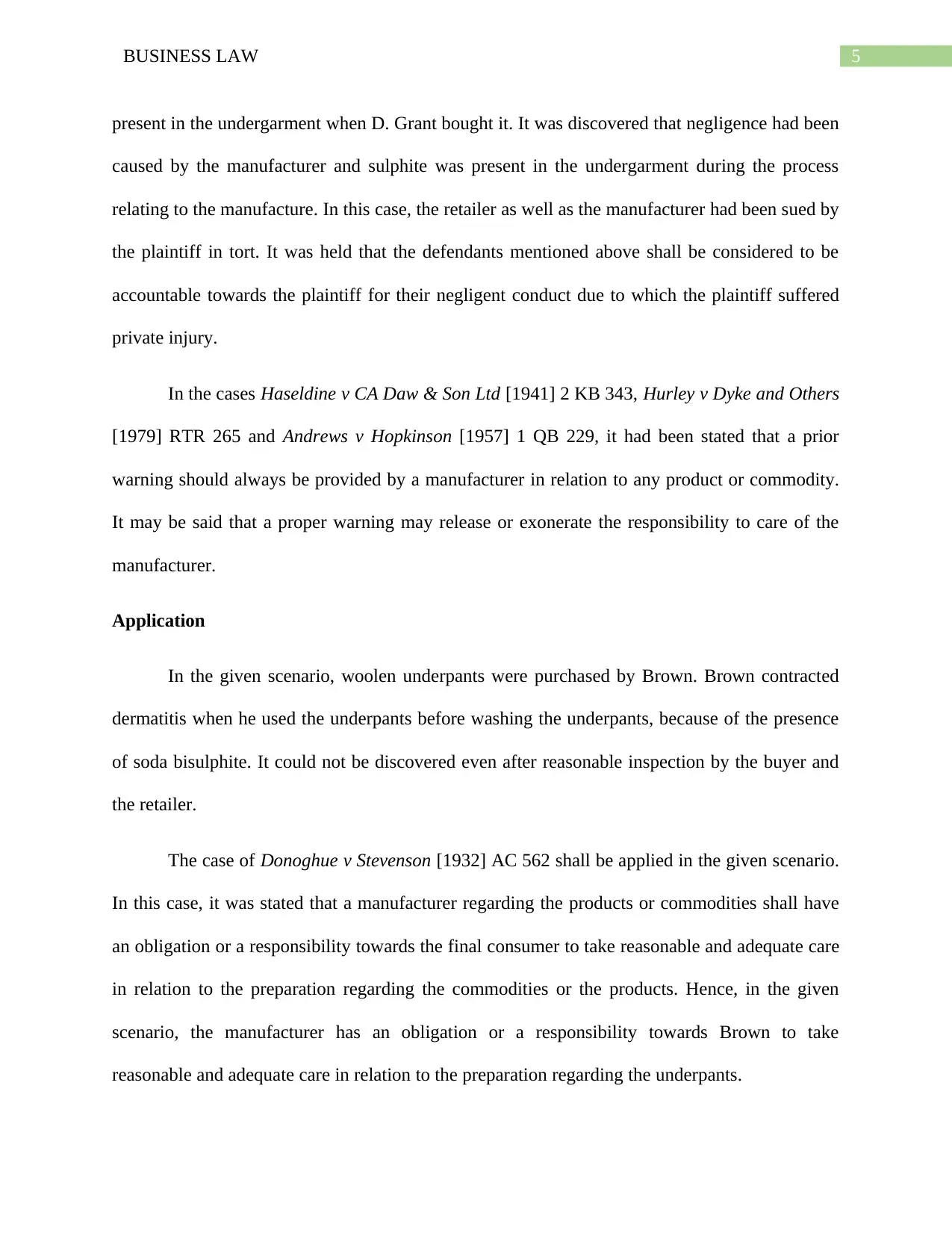
5BUSINESS LAW
present in the undergarment when D. Grant bought it. It was discovered that negligence had been
caused by the manufacturer and sulphite was present in the undergarment during the process
relating to the manufacture. In this case, the retailer as well as the manufacturer had been sued by
the plaintiff in tort. It was held that the defendants mentioned above shall be considered to be
accountable towards the plaintiff for their negligent conduct due to which the plaintiff suffered
private injury.
In the cases Haseldine v CA Daw & Son Ltd [1941] 2 KB 343, Hurley v Dyke and Others
[1979] RTR 265 and Andrews v Hopkinson [1957] 1 QB 229, it had been stated that a prior
warning should always be provided by a manufacturer in relation to any product or commodity.
It may be said that a proper warning may release or exonerate the responsibility to care of the
manufacturer.
Application
In the given scenario, woolen underpants were purchased by Brown. Brown contracted
dermatitis when he used the underpants before washing the underpants, because of the presence
of soda bisulphite. It could not be discovered even after reasonable inspection by the buyer and
the retailer.
The case of Donoghue v Stevenson [1932] AC 562 shall be applied in the given scenario.
In this case, it was stated that a manufacturer regarding the products or commodities shall have
an obligation or a responsibility towards the final consumer to take reasonable and adequate care
in relation to the preparation regarding the commodities or the products. Hence, in the given
scenario, the manufacturer has an obligation or a responsibility towards Brown to take
reasonable and adequate care in relation to the preparation regarding the underpants.
present in the undergarment when D. Grant bought it. It was discovered that negligence had been
caused by the manufacturer and sulphite was present in the undergarment during the process
relating to the manufacture. In this case, the retailer as well as the manufacturer had been sued by
the plaintiff in tort. It was held that the defendants mentioned above shall be considered to be
accountable towards the plaintiff for their negligent conduct due to which the plaintiff suffered
private injury.
In the cases Haseldine v CA Daw & Son Ltd [1941] 2 KB 343, Hurley v Dyke and Others
[1979] RTR 265 and Andrews v Hopkinson [1957] 1 QB 229, it had been stated that a prior
warning should always be provided by a manufacturer in relation to any product or commodity.
It may be said that a proper warning may release or exonerate the responsibility to care of the
manufacturer.
Application
In the given scenario, woolen underpants were purchased by Brown. Brown contracted
dermatitis when he used the underpants before washing the underpants, because of the presence
of soda bisulphite. It could not be discovered even after reasonable inspection by the buyer and
the retailer.
The case of Donoghue v Stevenson [1932] AC 562 shall be applied in the given scenario.
In this case, it was stated that a manufacturer regarding the products or commodities shall have
an obligation or a responsibility towards the final consumer to take reasonable and adequate care
in relation to the preparation regarding the commodities or the products. Hence, in the given
scenario, the manufacturer has an obligation or a responsibility towards Brown to take
reasonable and adequate care in relation to the preparation regarding the underpants.
⊘ This is a preview!⊘
Do you want full access?
Subscribe today to unlock all pages.

Trusted by 1+ million students worldwide
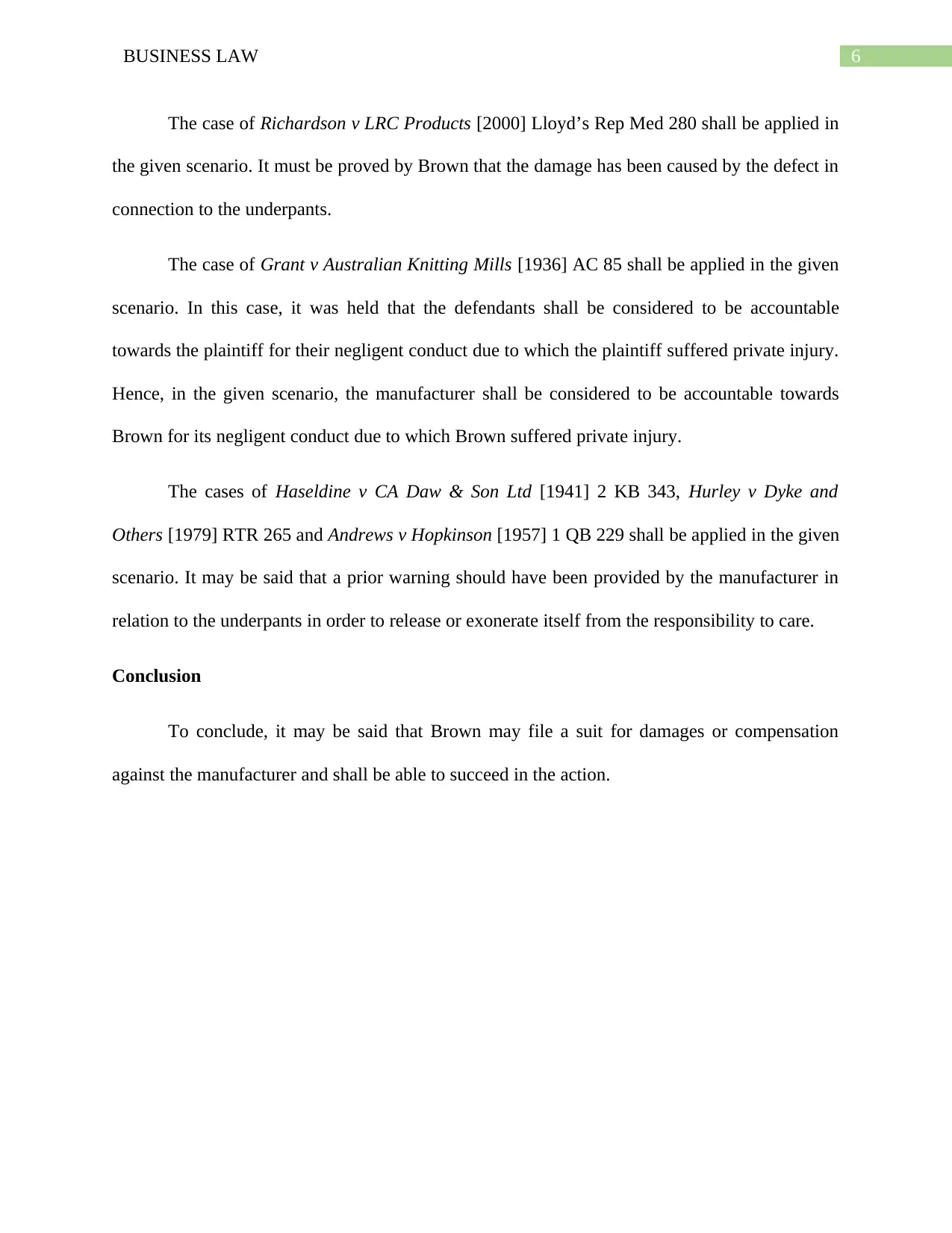
6BUSINESS LAW
The case of Richardson v LRC Products [2000] Lloyd’s Rep Med 280 shall be applied in
the given scenario. It must be proved by Brown that the damage has been caused by the defect in
connection to the underpants.
The case of Grant v Australian Knitting Mills [1936] AC 85 shall be applied in the given
scenario. In this case, it was held that the defendants shall be considered to be accountable
towards the plaintiff for their negligent conduct due to which the plaintiff suffered private injury.
Hence, in the given scenario, the manufacturer shall be considered to be accountable towards
Brown for its negligent conduct due to which Brown suffered private injury.
The cases of Haseldine v CA Daw & Son Ltd [1941] 2 KB 343, Hurley v Dyke and
Others [1979] RTR 265 and Andrews v Hopkinson [1957] 1 QB 229 shall be applied in the given
scenario. It may be said that a prior warning should have been provided by the manufacturer in
relation to the underpants in order to release or exonerate itself from the responsibility to care.
Conclusion
To conclude, it may be said that Brown may file a suit for damages or compensation
against the manufacturer and shall be able to succeed in the action.
The case of Richardson v LRC Products [2000] Lloyd’s Rep Med 280 shall be applied in
the given scenario. It must be proved by Brown that the damage has been caused by the defect in
connection to the underpants.
The case of Grant v Australian Knitting Mills [1936] AC 85 shall be applied in the given
scenario. In this case, it was held that the defendants shall be considered to be accountable
towards the plaintiff for their negligent conduct due to which the plaintiff suffered private injury.
Hence, in the given scenario, the manufacturer shall be considered to be accountable towards
Brown for its negligent conduct due to which Brown suffered private injury.
The cases of Haseldine v CA Daw & Son Ltd [1941] 2 KB 343, Hurley v Dyke and
Others [1979] RTR 265 and Andrews v Hopkinson [1957] 1 QB 229 shall be applied in the given
scenario. It may be said that a prior warning should have been provided by the manufacturer in
relation to the underpants in order to release or exonerate itself from the responsibility to care.
Conclusion
To conclude, it may be said that Brown may file a suit for damages or compensation
against the manufacturer and shall be able to succeed in the action.
Paraphrase This Document
Need a fresh take? Get an instant paraphrase of this document with our AI Paraphraser
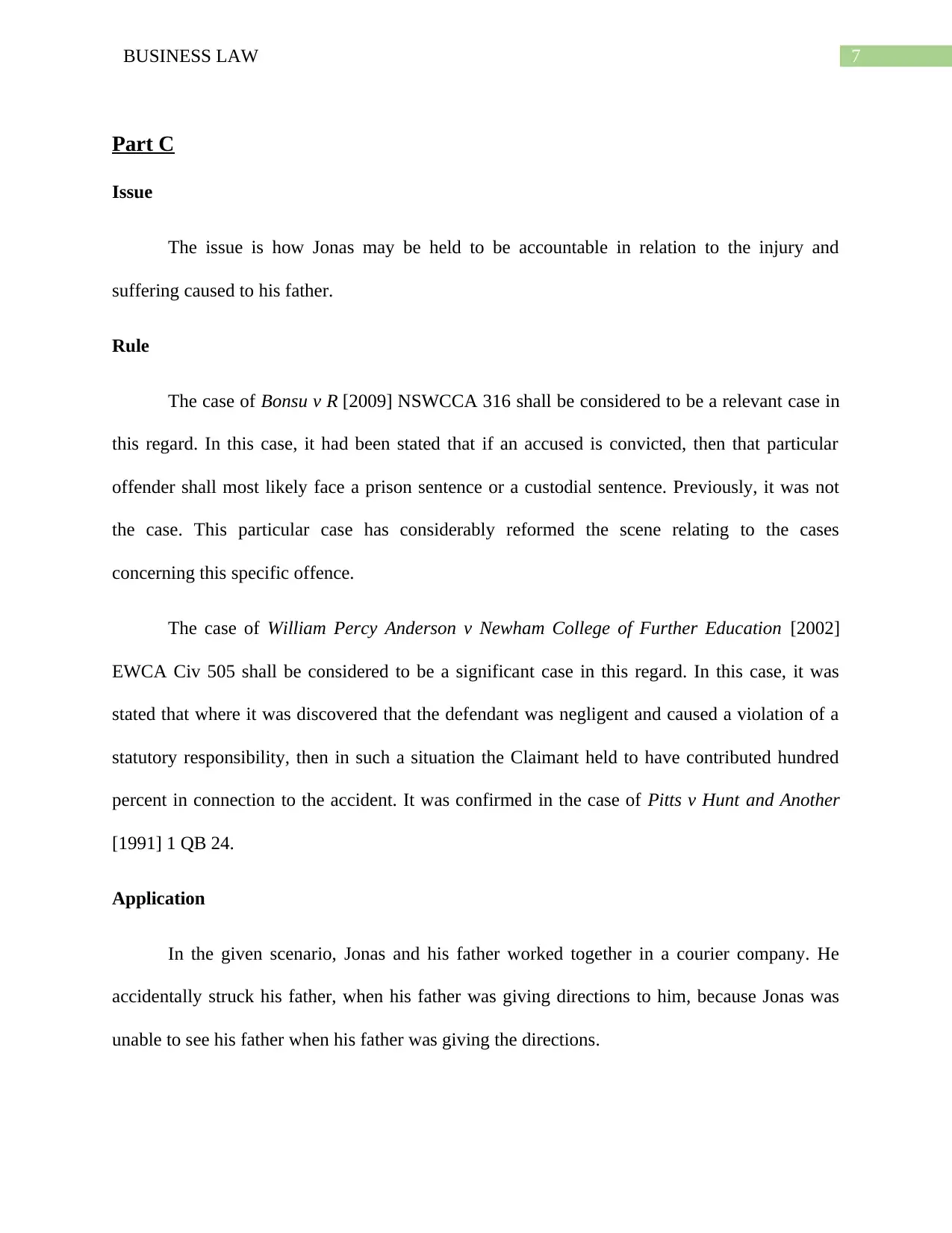
7BUSINESS LAW
Part C
Issue
The issue is how Jonas may be held to be accountable in relation to the injury and
suffering caused to his father.
Rule
The case of Bonsu v R [2009] NSWCCA 316 shall be considered to be a relevant case in
this regard. In this case, it had been stated that if an accused is convicted, then that particular
offender shall most likely face a prison sentence or a custodial sentence. Previously, it was not
the case. This particular case has considerably reformed the scene relating to the cases
concerning this specific offence.
The case of William Percy Anderson v Newham College of Further Education [2002]
EWCA Civ 505 shall be considered to be a significant case in this regard. In this case, it was
stated that where it was discovered that the defendant was negligent and caused a violation of a
statutory responsibility, then in such a situation the Claimant held to have contributed hundred
percent in connection to the accident. It was confirmed in the case of Pitts v Hunt and Another
[1991] 1 QB 24.
Application
In the given scenario, Jonas and his father worked together in a courier company. He
accidentally struck his father, when his father was giving directions to him, because Jonas was
unable to see his father when his father was giving the directions.
Part C
Issue
The issue is how Jonas may be held to be accountable in relation to the injury and
suffering caused to his father.
Rule
The case of Bonsu v R [2009] NSWCCA 316 shall be considered to be a relevant case in
this regard. In this case, it had been stated that if an accused is convicted, then that particular
offender shall most likely face a prison sentence or a custodial sentence. Previously, it was not
the case. This particular case has considerably reformed the scene relating to the cases
concerning this specific offence.
The case of William Percy Anderson v Newham College of Further Education [2002]
EWCA Civ 505 shall be considered to be a significant case in this regard. In this case, it was
stated that where it was discovered that the defendant was negligent and caused a violation of a
statutory responsibility, then in such a situation the Claimant held to have contributed hundred
percent in connection to the accident. It was confirmed in the case of Pitts v Hunt and Another
[1991] 1 QB 24.
Application
In the given scenario, Jonas and his father worked together in a courier company. He
accidentally struck his father, when his father was giving directions to him, because Jonas was
unable to see his father when his father was giving the directions.
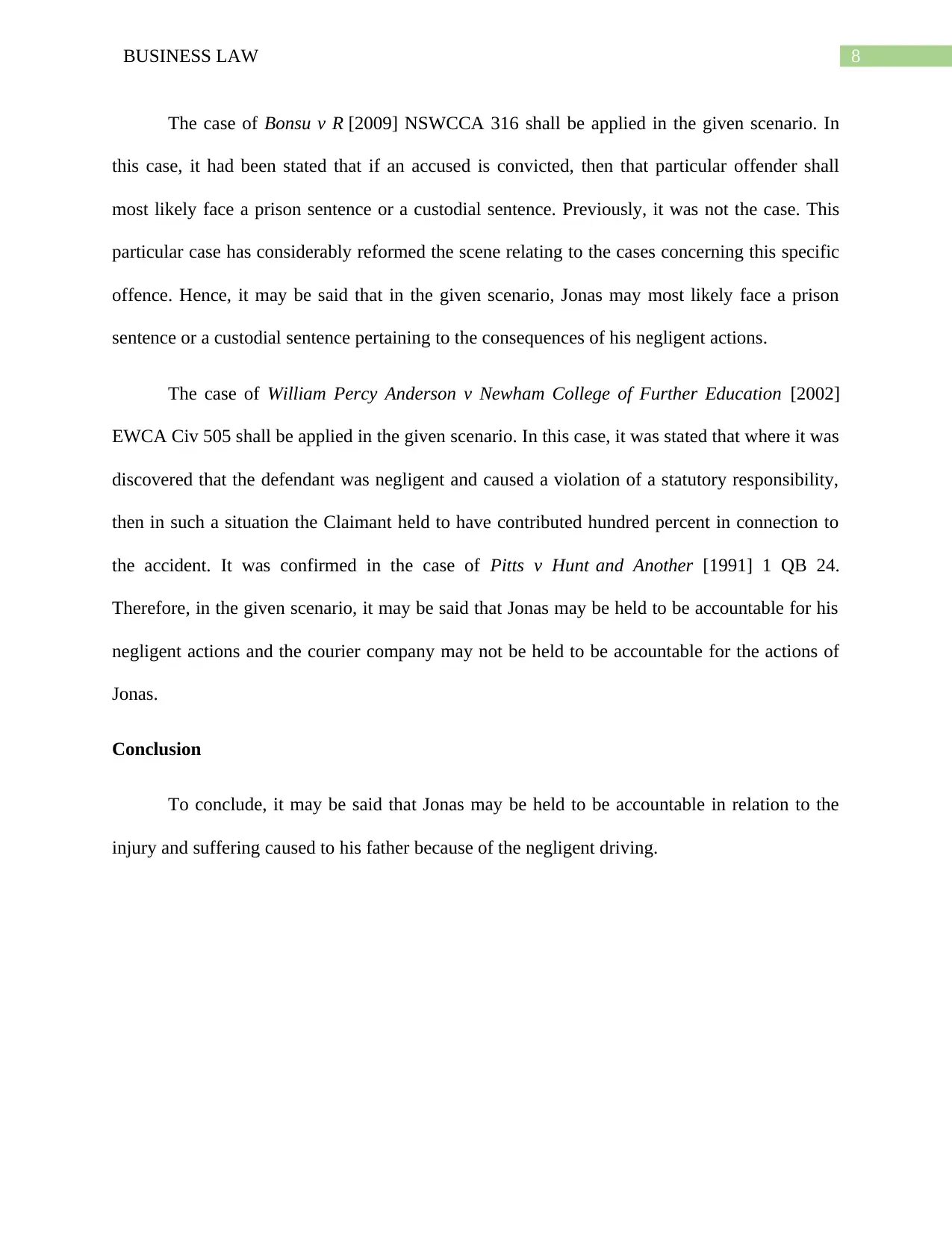
8BUSINESS LAW
The case of Bonsu v R [2009] NSWCCA 316 shall be applied in the given scenario. In
this case, it had been stated that if an accused is convicted, then that particular offender shall
most likely face a prison sentence or a custodial sentence. Previously, it was not the case. This
particular case has considerably reformed the scene relating to the cases concerning this specific
offence. Hence, it may be said that in the given scenario, Jonas may most likely face a prison
sentence or a custodial sentence pertaining to the consequences of his negligent actions.
The case of William Percy Anderson v Newham College of Further Education [2002]
EWCA Civ 505 shall be applied in the given scenario. In this case, it was stated that where it was
discovered that the defendant was negligent and caused a violation of a statutory responsibility,
then in such a situation the Claimant held to have contributed hundred percent in connection to
the accident. It was confirmed in the case of Pitts v Hunt and Another [1991] 1 QB 24.
Therefore, in the given scenario, it may be said that Jonas may be held to be accountable for his
negligent actions and the courier company may not be held to be accountable for the actions of
Jonas.
Conclusion
To conclude, it may be said that Jonas may be held to be accountable in relation to the
injury and suffering caused to his father because of the negligent driving.
The case of Bonsu v R [2009] NSWCCA 316 shall be applied in the given scenario. In
this case, it had been stated that if an accused is convicted, then that particular offender shall
most likely face a prison sentence or a custodial sentence. Previously, it was not the case. This
particular case has considerably reformed the scene relating to the cases concerning this specific
offence. Hence, it may be said that in the given scenario, Jonas may most likely face a prison
sentence or a custodial sentence pertaining to the consequences of his negligent actions.
The case of William Percy Anderson v Newham College of Further Education [2002]
EWCA Civ 505 shall be applied in the given scenario. In this case, it was stated that where it was
discovered that the defendant was negligent and caused a violation of a statutory responsibility,
then in such a situation the Claimant held to have contributed hundred percent in connection to
the accident. It was confirmed in the case of Pitts v Hunt and Another [1991] 1 QB 24.
Therefore, in the given scenario, it may be said that Jonas may be held to be accountable for his
negligent actions and the courier company may not be held to be accountable for the actions of
Jonas.
Conclusion
To conclude, it may be said that Jonas may be held to be accountable in relation to the
injury and suffering caused to his father because of the negligent driving.
⊘ This is a preview!⊘
Do you want full access?
Subscribe today to unlock all pages.

Trusted by 1+ million students worldwide
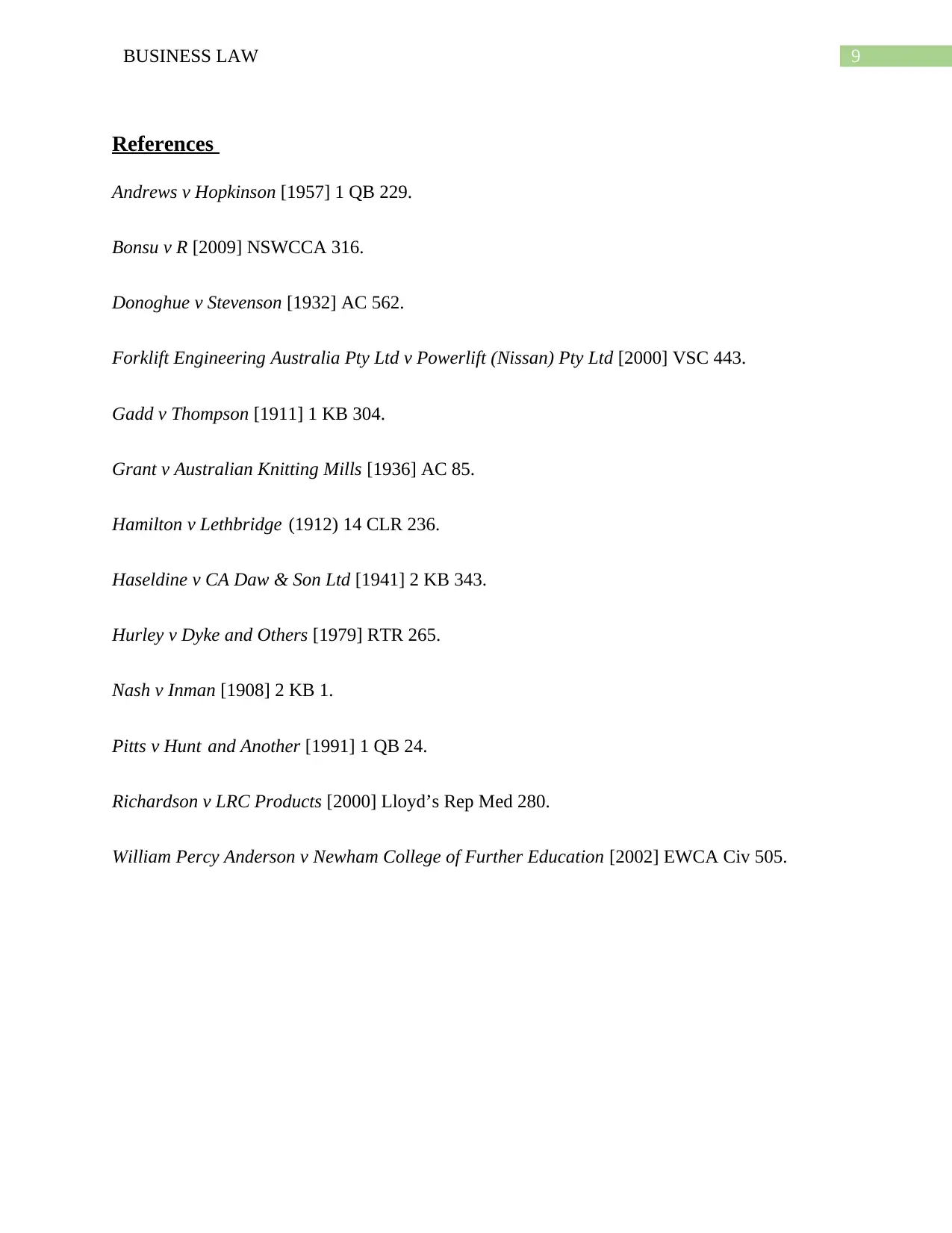
9BUSINESS LAW
References
Andrews v Hopkinson [1957] 1 QB 229.
Bonsu v R [2009] NSWCCA 316.
Donoghue v Stevenson [1932] AC 562.
Forklift Engineering Australia Pty Ltd v Powerlift (Nissan) Pty Ltd [2000] VSC 443.
Gadd v Thompson [1911] 1 KB 304.
Grant v Australian Knitting Mills [1936] AC 85.
Hamilton v Lethbridge (1912) 14 CLR 236.
Haseldine v CA Daw & Son Ltd [1941] 2 KB 343.
Hurley v Dyke and Others [1979] RTR 265.
Nash v Inman [1908] 2 KB 1.
Pitts v Hunt and Another [1991] 1 QB 24.
Richardson v LRC Products [2000] Lloyd’s Rep Med 280.
William Percy Anderson v Newham College of Further Education [2002] EWCA Civ 505.
References
Andrews v Hopkinson [1957] 1 QB 229.
Bonsu v R [2009] NSWCCA 316.
Donoghue v Stevenson [1932] AC 562.
Forklift Engineering Australia Pty Ltd v Powerlift (Nissan) Pty Ltd [2000] VSC 443.
Gadd v Thompson [1911] 1 KB 304.
Grant v Australian Knitting Mills [1936] AC 85.
Hamilton v Lethbridge (1912) 14 CLR 236.
Haseldine v CA Daw & Son Ltd [1941] 2 KB 343.
Hurley v Dyke and Others [1979] RTR 265.
Nash v Inman [1908] 2 KB 1.
Pitts v Hunt and Another [1991] 1 QB 24.
Richardson v LRC Products [2000] Lloyd’s Rep Med 280.
William Percy Anderson v Newham College of Further Education [2002] EWCA Civ 505.
1 out of 10
Related Documents
Your All-in-One AI-Powered Toolkit for Academic Success.
+13062052269
info@desklib.com
Available 24*7 on WhatsApp / Email
![[object Object]](/_next/static/media/star-bottom.7253800d.svg)
Unlock your academic potential
Copyright © 2020–2025 A2Z Services. All Rights Reserved. Developed and managed by ZUCOL.





